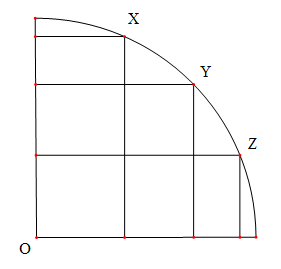To solve the problem in yesterday’s post, we need to do some length chasing…

Recall that we want to find the length of in the diagram above. We have to find ways to express
using the quantities that we know, which are
Let us see if similar triangles can help us simplify the problem. There are several similar triangles that we can find easily due to properties of circle, namely and
. From the former set of similar triangles, we have:
The next 2 quantities that we have to chase are and
can be related using the similar triangles
which is not bad, since all these quantities are given or can be derived using Stewart’s theorem. Before plugging in the values, we try to derive an expression for first using power of a point theorem. We have:
So
Right now, we can use Stewart’s theorem to derive the length of . You can also manipulate Stewart’s Theorem to give you the following expression:
Hence,
Many weeks ago I gave this problem in the first post of the blog:
Suppose are real numbers that satisfy
. Prove that
Weird problems call for weird methods. This inequality is unconventional because it contains both trigonometric function and the constant in the same expression. We also notice that the inequality is strict and hence it is futile to find the equality case. Let us transform the inequality into this form using double angle formula and see if it means anything:
Many people may try using product to sum formulas or calculus to prove the above inequality. However, these methods will not lead to any results and are very nasty to manipulate. The key to this problem is to figure out the significance of .
Note that is the area of a quarter of a circle. It seems like every term in the inequality represents some sort of area within a quarter circle. Consider the diagram below:
With this diagram, the inequality becomes more apparent. Rearranging the inequality, it gives us:
The left hand side of the inequality is the area of the quarter circle with radius 1. The expression on the right represents the union of the areas formed by the three rectangles defined by points . No matter where these three points are, the area of these rectangles will always be smaller than the area of the quarter circle!
Questions that involve geometric construction are very rare, but their proofs are very elegant and rewarding. Try proving the following inequalities with geometric construction:
1) Prove that where
is a real number.
2) Given 100 positive real numbers that satisfy
Prove that there exist three numbers from this set such that the sum of these three numbers is larger than 100.
Cheers,
ksj
